Verses of minor art: definition and examples

The poems are lyrical compositions They have their own rules for training, resources, and measurement. The metric is an essential part when it comes to being able to know a poem in a formal way and being able to understand and identify it. In this lesson from a TEACHER we will discuss definition of verses of minor art with examples. Poetry has different classifications and licenses that constitute its own rules of analysis. Let's see some of them.
In order to understand what a minor art verse is, we must first define verse. Therefore, if we look at its concept, we can say that a verse is the smallest unit of a poem. In other words and represented graphically, it is the one that occupies each line of a poem. For the poem to be considered as such it must have a rhythm and this can only be achieved by following a series of schemes of distribution of stressed syllables, the number of syllables their rhyme and the metric pauses of the same.
Since our objective is to talk about the verses of minor art, we must therefore focus on the
number of syllables that make up each of the verses, since they will be responsible for telling us if the verse is of major art or minor art.Thus, at this point, we can point out that a minor art verse will be defined by the number of syllables it has. So how many types of verses are there? The answer is simple, just there are two types of verses:
- Verses of major art
- Minor art verses
These will depend on the number of syllables they have. Thus, the first ones, those of major art, will be those whose total count of syllables per verse is greater than 8 syllables and those of minor art, those that have less than this figure.
How verses are measured
The definition and grouping of the types of verses is very simple and you just have to remember the number 8 as a reference. But not everything is so simple, when measuring a verse it must be taken into account that the syllables will not be counted in the same way that they are represented in writing.
To this measure it will be necessary to add a series of metric licenses which are based on a series of basic rules:
- The law of the final accent: in it, each word must add or subtract a syllable, taking into account what kind of word is at the end of each verse.
- Sinalefa: is the union in a syllable of the final vowel of a word with the initial of the next, despite the fact that these represent two different syllables in the written word.
- Syneresis: used to unite two vowels that appear forming a hiatus within the same word in a single metric syllable.
- Dieresis: in this case the diphthong formed in a word is divided into two different metric syllables.
- Hiatus: it is the breaking of a synalepha due to the fact that one of the vowels that the form is accentuated.

We already know how verses are measured and the metric licenses and standards that we must apply when we want to count their syllables, so It is time to establish the classification of the different types of verses that you will be able to find when you are analyzing any poem. You must bear in mind that there are no single syllable verses, so minor art verses will be those that contain between two and eight metric syllables.
Two syllable verses
The first that we find are the verses formed by two syllables, these are called bisyllables. Let's see an example in a poem by Gertrudis Gómez de Avellaneda entitled The sleepless night and the dawn to understand them better:
Night / sad / saw / already
In this stanza we can see that all of her verses have two syllables. Note that the latter only has one word and is a monosyllable, due to the law of final accent, in which acute words add up to one syllable.
Three syllable verses
They are called verses trisyllables and they are the ones that after their count make up a total of three syllables per verse. An example of this is this fragment of The Salamanca student by José de Espronceda:
Such, sweet / sighs / the lyre / that wounded / soft / cencento / of the wind / the voice.
We see that each of the verses contained in this stanza has 3 syllables each.
Four syllable verses
They are called verses tetrasyllables since they include four syllables after taking the measurement. As our objective is that you learn to distinguish them correctly, we are going to see an example in these verses of The song of the pirate by José de Espronceda. In this fragment we can clearly see how the author has opted for the inclusion of tetrasyllable verses:
Twenty dams / we have done / in spite / of English
Five syllable verses
In the case of the verses that are composed of five syllables, we are talking about the verses pentasyllables. We can find them in these verses by an anonymous author on the death of Guillén Peraza:
Cry the ladies / if God is worth to you. / Guillén Peraza / was left in the palm / the withered flower / of his face.
Six syllable verses
The verses composed of six syllables are called hexasyllables and we can find some examples in poetry such as the poem by José Gorostiza entitled At the sea's shore:
The discreet / friendly, simple things; / things come together / like shores.
Seven syllable verses
The verses heptasyllables are those that are made up of verses that contain a total of seven syllables. Something that we can understand very well with the following example obtained from a poem by Garcilaso de la Vega entitled If my low lira:
If from my low lira / so much could the son / that in a moment.
Eight syllable verses
They are the most common verses in poetry, these are called octosyllables and we can find them in a multitude of compositions such as romance. Let's see an example in this rhyme by Gustavo Adolfo Bécquer:
For a look a world, / for a smile a sky, / for a kiss, I don't know / what I would give you for a kiss.
These are the verses of minor art, their definition and examples so that you can understand them better and know how to measure them correctly when you have to analyze them.

Image: Slideplayer


